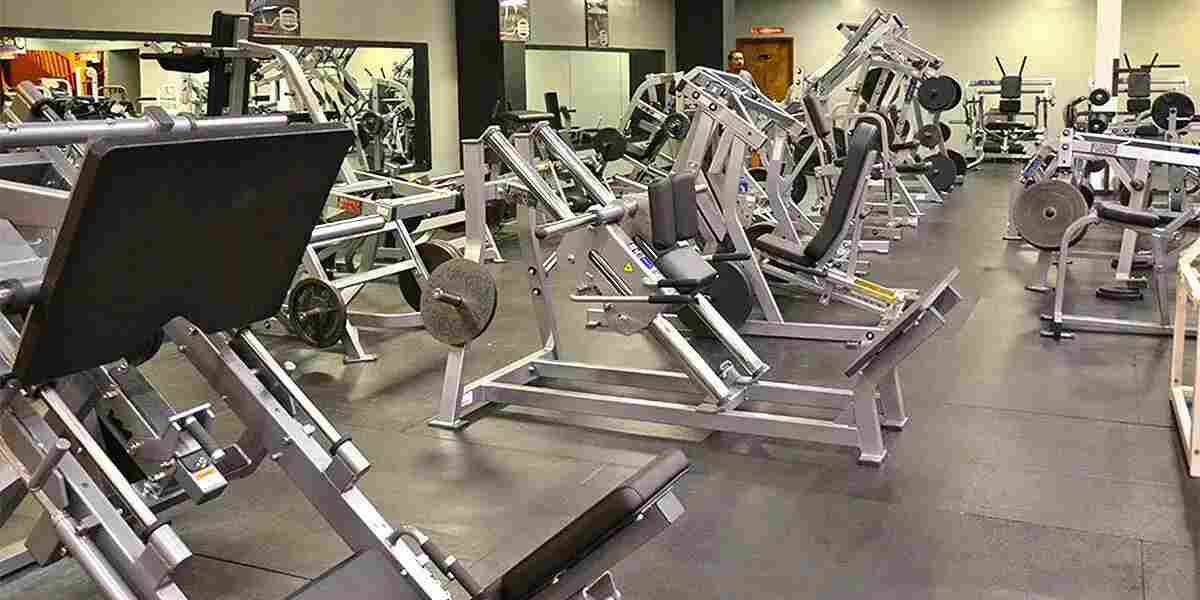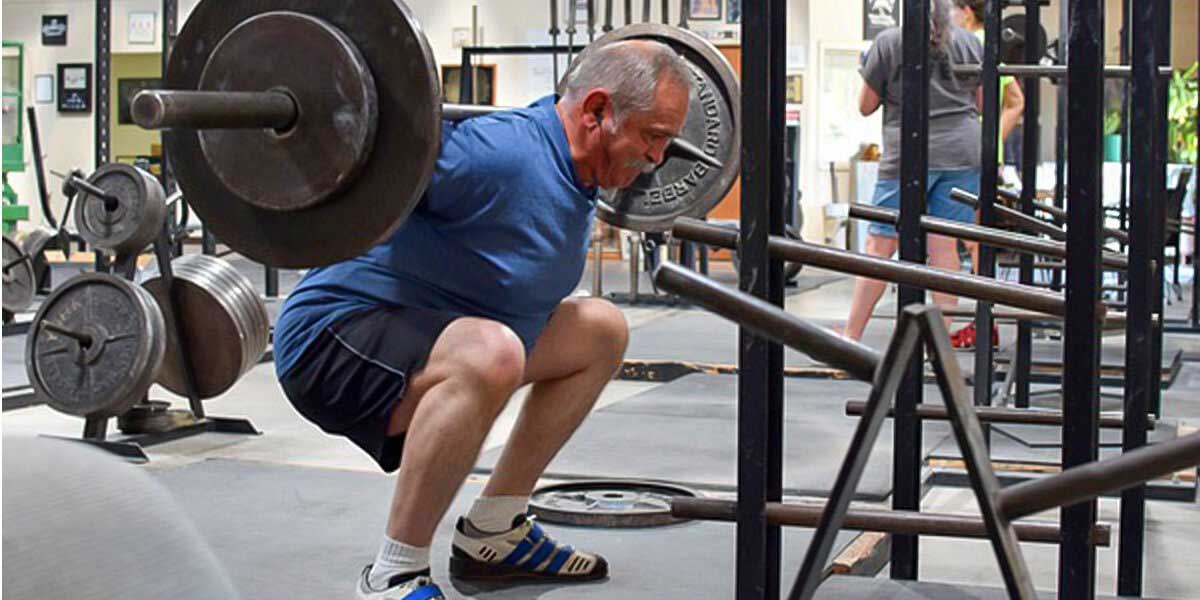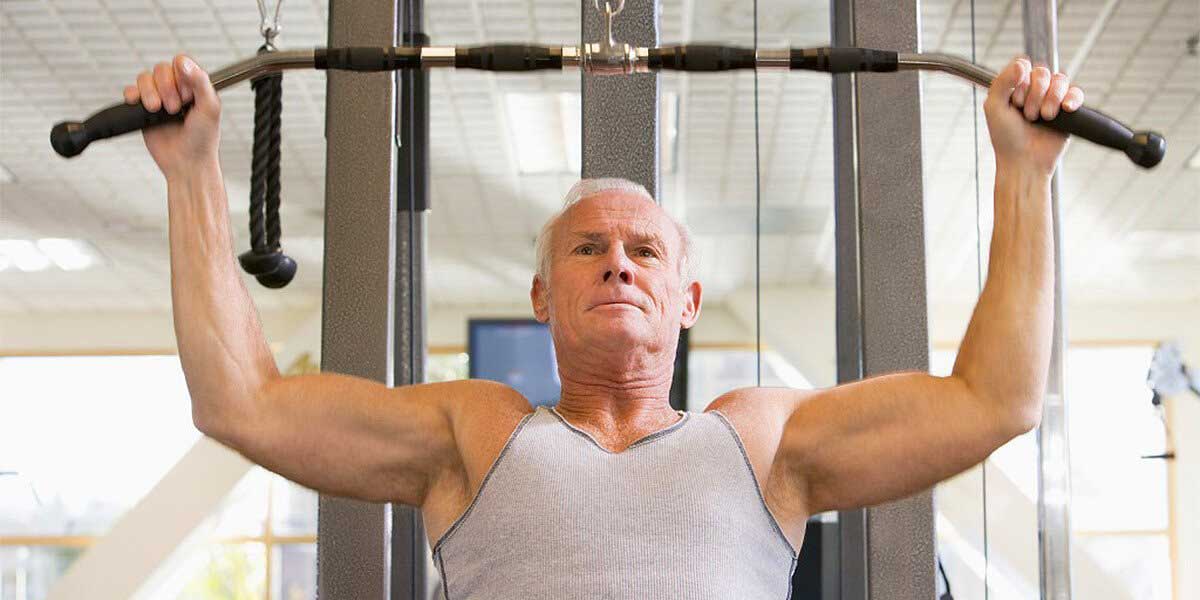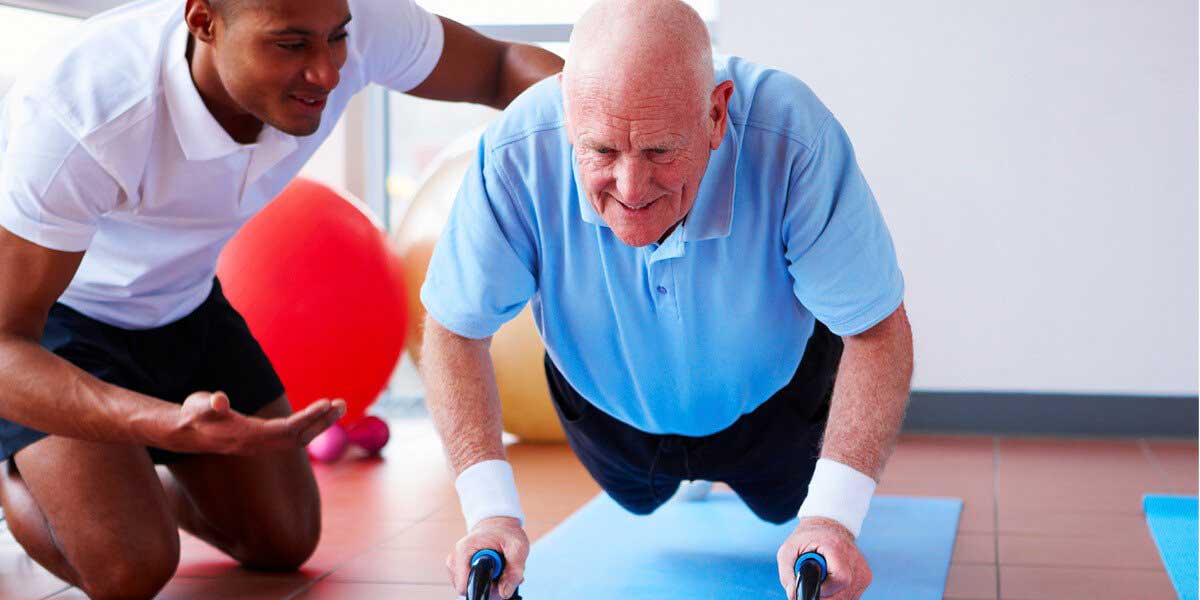800-487-3808
800-487-3808

Whether you’ve been training your whole life or are picking up weights for the first time, strength training is crucial for building muscle after 50. Healthy muscles and a strong core support aging joints to relieve pain and improve your overall quality of life. Getting up and down, performing daily tasks, and living your life become easier. Plus, you decrease your risk of developing conditions like osteoporosis. You don’t have to be a bodybuilder to get started. We’re going to talk about how to build muscle after 50, simple exercises that will give you the most bang for your buck, and how to properly fuel your body for workouts. Ready to get stronger and remain independent for years to come? Let’s get started!
When it comes to getting stronger and building muscle after 50, planning is key. Having your exercise routine laid out before you walk in the gym means you get right down to work—and keep your confidence up by knowing exactly what you’re doing.
As you’re developing your exercise plan, focus on maintaining consistency. Doing a little a lot will lead to huge benefits. You’ll feel better, and life will become easier. Come up with a plan and stick to it to maintain your strength and independence as you age.
To help you get started, we’ve laid out some basics: setting your schedule, deciding when and where to train, and some simple exercises that are perfect to ease you into your new exercise regimen.
Start by piecing together your schedule. You can do this by asking yourself these three questions.
We strongly recommend you create a regular routine that involves lifting at least 2 to 3 days per week.
Studies show this is the minimum frequency needed to achieve the benefits of lifting after 50. More days can lead to more benefits, but you need to consider your ability and potential limitations.
The U.S. Department of Health & Human Services states in their Physical Activity Guidelines for Americans:
You may hear different opinions about the ideal time to work out, but choose the best time for your life and body. It may be easier for you to work out earlier in the day because you're too tired in the evenings. Conversely, you may be more motivated later in the day. Both morning and evening exercise have their benefits. Getting the workout in is what counts.

The gym is full of equipment you won't have at home—machines, free weights, squat racks, and cardio machines. ( Image Reference)
You’ve got a few options for places to train, and there are advantages to each.
Wherever you choose to work out, stick to your goals and your schedule.
Basic lifting movements will form the basis of your workout routine. To get you started, check out these strength training exercises to help you start building muscle after 50.
Free weights include barbells and dumbbells and force your body to work in unison. Multiple muscle groups work together to build functional strength. Benefits of free weights include:
Remember, free weights can be dangerous when used without proper form. Always have your form assessed by a professional, and never increase weight before you're ready.
 Squats have been called the "king of all exercises" because they build functional lower body and core strength. ( Image Reference)
Squats have been called the "king of all exercises" because they build functional lower body and core strength. ( Image Reference)
Step 1: Place the barbell on your lower shoulders. Do not rest it on your neck.
Step 2: Stand with feet at hip width. Hold a deep breath. Drop your hips, keeping your chest up and eyes forward.
Step 3: Squat to parallel, if you can do so comfortably.
Step 4: Exhale and push through your heels. Maintain a strong core and good balance.
Imagine you are spreading the floor with your knees. If your knees tend to cave, squat with a band around them to practice pressing out with your knees and driving through your heels.

Weight machines are great for targeting specific muscles, but that strength doesn't always translate to free weight exercises or daily life. ( Image Reference)
Exercise machines are great for beginners. They isolate muscle groups, and because they direct you through the range of motion, they pose less risk of injury than free weights. Benefits include:
Keep in mind, weight machines do not develop your core and stabilizing muscles like free weights. The weight you handle on a leg press will not translate to back squats.
Read each machine's instructions before you use it, or ask for help from gym staff.
Step 1: Load the plates onto the machine.
Step 2: Situate yourself in the seat, with your feet flat on the platform and knees bent at a comfortable angle.
Step 3: Drop the safety catch. (Your feet should not go below the catch while using the machine. Adjust the catch if necessary.)
Step 4: Extend your legs, without locking your knees. Slowly lower until your knees are at a 90-degree angle.
Step 5: Exhale and extend your legs. Repeat for the desired number of reps.
Never allow weights to fall when using machines. Lower slowly and control the weight back to the starting position.
Bodyweight strength training exercises involve working against the resistance of your own body weight. Bodyweight training has several key benefits:

If you can't do a full push up, elevate your hands on a chair or table. Eventually, work up to adding weight to your back. ( Image Reference)
Step 1: From a plank position, with arms tight to your sides, lower until your nose touches the ground. Keep your back flat and core tight.
Step 2: Push up to the starting position. Repeat for the desired number of reps.
Step 1: With one leg forward, drop your back knee toward the ground. Keep your core tight and head up.
Step 2: Push yourself up. Step forward, and repeat with the opposite leg.
Certain cardiovascular exercises have strength training components. For example, climbing stairs develops your quad strength. Benefits of regular cardio include:
To maintain good health, aim for two and a half hours of moderate aerobic activity per week.
Step 1: Climb on a stair climber or a set of stairs.
Step 2: After each step, extend your lower leg behind you and squeeze your butt.
Step 3: Repeat with the other leg.
Step 1: Climb the stairs laterally, facing sideways.
Step 2: Cross one leg in front of the other.
Step 3: Turn to face the other side, and repeat.
Some people avoid the gym simply because they’re not sure what to do when they get there. Have you ever faced a gym full of machines and free weights and had no idea where to start? We can fix that! Follow this simple workout routine, and get your work in like a pro.
Rest 30 seconds to 1 minute between sets. Select a weight that is about 75% of the maximum you can lift. Never attempt to lift your max weight for reps.
Ladies, have you ever walked in the gym and headed straight for the cardio machines? Maybe you watch the gym-goers out on the floor and think you’d like to try more strength training, but you don’t know where to start. Dive in and give it a go! The following workout routine is a fantastic starting point.
Rest 30 seconds to 1 minute between sets. Select a weight that is about 75% of the maximum you can lift. Never attempt to lift your max weight for reps.

Proper nutrition is key for building muscle. Eat all the necessary nutrients and plenty of protein. ( Image Reference)
Eating the right amount of calories, eating plenty of protein, and getting all the nutrients and vitamins we need are key to building muscle after 50.
Building muscle to compensate for natural, age-related muscle loss, requires an increased caloric intake to allow muscles to repair and grow. Speak with your doctor to determine your unique needs, but here are general guidelines.
Protein is essential for building muscle, and protein intake should increase with age. If you are building muscle, plan to eat more than the recommended amount of protein. Ask your doctor or dietitian for an individual recommendation, but the following amounts are standard.
Supplement your protein intake with clean protein bars and powders.
Carbs give you energy and fuel your workout. Focus on whole grains and complex carbohydrates that are high in fiber. You will feel less hungry throughout the day and be healthier overall.
Several nutrients play an important part in building muscle. Work these into your regular diet.

You’re more likely to stick to your goals and your strength-training schedule if you connect with a friend or a group. Find a training partner, or take a class at the gym. You’re sure to meet new people and develop a strong support system.
You should set short- and long-term goals. A good short-term goal might be lifting three days per week for a month. A long-term goal might be to increase your bench press or complete an endurance race.
Slow and steady wins the race. Follow the schedule you set and you will see results over time. Start making strides today.
Building muscle is great, but only if you are taking care of yourself while you do it. Remember to get plenty of sleep, drink lots of water, and eat a balanced diet. Always stretch and warm up before you exercise, and remember to cool down after each workout.
You may be getting older, but don’t underestimate the powerful and resilient nature of the human body. Research shows that it is absolutely possible for older adults to gain muscle. This goes beyond simply combating muscle loss!
Several research studies show that exercise can reduce the risk of falls by nearly 20%. Falls are a primary cause of chronic pain, functional impairment, disability, and death in older adults.
Lifting weights will increase your walking speed and make daily life easier. Plus, it'll be much easier to get out of a chair!
With better balance and improved functional mobility comes independence. You won't need to rely on your kids or a neighbor.
An overwhelming amount of research indicates that exercise prevents disease. Lifting weights reduces the risk of osteoporosis and prevents bone loss. It also improves symptoms related to heart disease, arthritis, and diabetes. Lifting can even reduce pain in osteoarthritis patients.
Lifting is one the best and most natural ways to get a mood boost! It can even lead to better sleep!
Strength training ignites your metabolism, which leaves your body ready to burn food like a roaring furnace! And those with low body fat percentages have higher metabolic rates.
It’s easy to do too much too soon. Here are common mistakes to avoid so you stay safe and enjoy your workout.
It's important to prepare your muscles for the movements they're about to perform. Always do a bodyweight or light-weight warm up before jumping into your lift to prepare your neuromuscular system.
Give your body plenty of time to prepare for heavier loads by developing balance and muscular endurance. When you're first starting out, lift lighter weights for higher reps and focus on developing core strength and perfect form.
All movements should be fluid. Lift and lower weights in a slow and controlled motion, and never lock your joints. Try working with a personal trainer to learn proper form from the get-go.
Muscle loss won’t go away. It will continue every decade until you end up in pain. Why not carve out a new trajectory for yourself? Building muscle will reduce your risk of falls and help you live longer with more independence. Your future self will thank you. Use the exercises we’ve laid out and add your own. Most importantly, stick to your schedule and your goals, and always fuel your body with healthy, muscle-building food.
Sources:
https://www.webmd.com/healthy-aging/guide/sarcopenia-with-aging#1
https://health.gov/dietaryguidelines/2015/guidelines/appendix-1/
http://www.livestrong.com/article/367521-is-cardio-bad-for-building-muscle/
Sherrington, C. et al. (2008). Effective Exercise for the Prevention of Fall: A Systematic Review and Meta-Analysis. Journal of the American Geriatrics Society, 56(12), 2234-2243.
Liu, C. J. & Latham, N. K. (2009). Progressive resistance strength training for improving physical function in older adults. Cochrane Database of Systematic Reviews.
Kannus, P. et al. (2005). Prevention of falls and consequent injuries in elderly people. The Lancet, 366 (9500), 1885-1893.
Seguin, R. & Neson, M. E. (2003). The benefits of strength training for older adults. American Journal of Preventive Medicine, 25(3), 141-149.
Brown, A. B., McCartney, N. & Sale, D.G. (1990). Positive adaptations to weight-lifting training in the elderly. Journal of Applied Physiology, 69 (5) 1725-1733.
Hurley, B.F. & Rot h, S.M. Sports Med (2000) 30: 249.
Zuti, W.B. & Golding, L.A. Effect of Diet and Exercise on Weight Loss and Body Composition of Adult Women. The Physician and Sports Medicine. 4 (1): 49-53, 1976.
Esmarck, B., Andersen, J. L., Olsen, S., Richter, E. A., Mizuno, M. and Kjær, M. (2001), Timing of postexercise protein intake is important for muscle hypertrophy with resistance training in elderly humans. The Journal of Physiology, 535: 301–311. doi:10.1111/j.1469-7793.2001.00301.x
Leave a comment